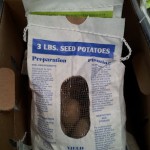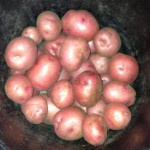
A common misconception is that all potatoes come from the Midwest. However, select Irish potato varieties are produced commercially in Florida on over 20,000 acres. Potatoes can also be grown in Florida home gardens if care is taken to select the correct type and recognize proper timing.
Potatoes are a cool season crop and the ideal time to plant in the Florida Panhandle is in January and February. Valentine’s Day is a good target planting date for home gardeners with plants producing tubers after about three months (variety and weather dependent).
The ideal site for potatoes has well-drained soils with a pH range of 5-6. To increase drainage, beds can be formed into hills that are 10-12 inches above the soil. Another option is to grow potatoes in raised beds or containers to ensure the plants will not sit in water during heavy rains.

Use certified “seed” potatoes to ensure you are starting with healthy tubers. Cut seed potatoes into egg sized pieces that contain at least one eye each. Allow the cut seed pieces to heal for a couple of days in a cool, dark spot with good ventilation. After healing they can be planted about four inches deep 6-8 inches apart with three feet between rows.
Sometimes potatoes will push to the surface of the soil and will need to be covered with more soil (hilling). If the potatoes are not covered, they can become damaged by the sun and inedible.
Keep your garden weed free to minimize competition with your crop and to also reduce the likelihood of weeds harboring insects or disease that can be harmful to potato plants.
A few weeks after planting seed potatoes, you should begin to see some vegetative (leaves and stems) growth above the soil. Potato plants can grow over a foot tall and are bushy. Small new tubers start to form underground before blooming, but they need more time to bulk up before harvesting. The entire growing process takes between 80 and 115 days from planting to harvest.
 If you plan to store your potatoes, allow them to remain in the ground for 2-3 weeks after the top of the plant has died to fully mature. If the vegetative portion of the plant does not die on its own the top can be cut to induce maturation of the tubers.
If you plan to store your potatoes, allow them to remain in the ground for 2-3 weeks after the top of the plant has died to fully mature. If the vegetative portion of the plant does not die on its own the top can be cut to induce maturation of the tubers.
For recommended varieties and more information on care and harvesting please see “Growing Potatoes in the Florida Home Garden.”
 0
0

Comments:
May 28, 2021
You will need the minus sign. In the ArcGIS search box type in the Decimal Degree conversion. for Fountain Bleu Box Cars -85.8833, 30.15 https://arcg.is/ubaHD
May 2, 2021
How do you put the negative number when I try to enter without no (-) tells me I am 4,000 miles away
April 26, 2019
Just a quick note thanking you all for providing valuable recovery information and tools.
February 13, 2019
Hi Susan, Registration opened on the 11th, and future events will also be 10 days before the event. The link to register is here https://uf_ifas_part2_shrubs.eventbrite.com If you have any trouble getting signed up please email me at juliebmcconnell@ufl.edu. I apologize for the delayed response, notifications on the website are not sent directly to me. Julie
January 20, 2019
Hi Julie, When do you expect to open up ticket purchases for the next seminar on February 21st? Thank you so much for these series! Susan Higby
July 3, 2016
Latest release from Health Department in Bay County / Bay County TDC via Twitter June 28, 2016 https://twitter.com/Visit_PCB/status/748315619682983936
June 17, 2016
Yes, I had a call about this problem this morning, they are here in Bay County
May 6, 2016
I noticed aphids on my lettuce and planned to take them in to show some students. On the planned date I found they they had been consumed by parasitic wasps. I felt it was a sign of a balanced ecosystem.
February 3, 2016
Where can I find seed potatoes (red)? I am in Gulf Breeze.
July 22, 2015
I was actually wondering about the issue with the mower blades. I am constantly getting the ends of the grass cut on a way that has the tip of it drying out. Is the fact that the blades are a little worn, that is causing this issue of the grass getting dry at the top.
June 8, 2015
For sure on the Aucuba! I love it and use it throughout my front yard along with the cast iron plants. One of my favorite shade plants however is the Apostle's Iris, 'Neomarica gracilis'. They have survived the coldest winters so far and have come back beautifully. Thanks for the article. I have 2 shady beds I am renovating right now so I look forward to finding the Japanese Plum Yew and the Mahonia!
April 19, 2015
An evergreen shrub that does well in the shade for me is Aucuba japonica 'Serratifolia' An all green aucuba.
April 15, 2015
Nice article Julie. Just a side note that occurred to me as I looked at the pictures. Please don't recommend (I know you didn't in this article) that people plant close to the flare roots of a tree. The first radial distance of 3x the DBH of the tree is very, very important root area and what the arborist needs access to for many treatments. As important, perhaps more important is: 1. the tree trunk and exposed flare roots need to be dry when it is not raining and having vegetation in close proximity eliminates the breeze and keeps the tree trunk damp creating a decay/fungi opportunity; 2. cast iron plant, Jasmine, fern, etc. are major competitors in that critical root area. If a tree is stressed one of the cultural remedies is to clear out plants in that critical root area and install organic mulch, preferably pine straw. Keep up the good work!!
March 26, 2015
Hi Stan, I don't know how frequently that is done, however, if the gardener plans to change out the plants after a very short period of time they may leave them in containers. Some commercial properties may do that if they plan to swap out if anything declines (theme parks, other high profile spots), but most plants should not stay in original containers indefinitely. Eventually the plant's root system will outgrow the pot and will be unable to take up enough water to sustain itself. Julie
March 14, 2015
Miss McConnell, Is it a common practice by some homeowners to leave the annuals in their pots when they plant them in the Spring? Thank you
December 5, 2014
Hi David, The palm you are describing is likely Butia capitata also known as Jelly Palm or Pindo Palm. The fronds have a bit of a blueish or silvery color to them that makes them fairly distinctive. More can be found about this palm at the following link http://edis.ifas.ufl.edu/pdffiles/ST/ST10500.pdf. If you like, send a picture to my email and I can confirm if that's what you have. Have a great day! Julie juliebmcconnell@ufl.edu
December 4, 2014
We have a palm, locally known as a Jelly Palm" It's a very slow growing, like 12 feet in 15 years, and very bushy compared to the typical King palm. It puts out small groups of flowers, inside a hard, 3-4 ft. long woodlike, split, shell, which, of course become seeds. That is apparently what some old timers used for "Jelly:". Jelly Palm is not likely it's correct name. From that vague description, can you tell me what it is, or if not, what I can provide to help properly name it.
November 5, 2014
Please give me a call. I would like to discuss how Farm Credit can be involved in this program. My number is 850-718-5511. Thanks, Lesia Andrews
September 7, 2014
Hi John, Butterflies are rather specific about where they lay eggs and which plants their larvae (caterpillars) will feed on. For the Gulf Fritillary, the passionflower vine is the preferred larval host. I would not expect having this plant in your garden would have any direct effect on the number of caterpillars that would target tomatoes and peppers. If you would like to learn more about pests that are more specific to tomatoes and peppers, please see the following publication at http://edis.ifas.ufl.edu/pdffiles/IN/IN16900.pdf "Insect Management for Tomatoes, Peppers, and Eggplant"
September 3, 2014
if I plant this purple passionflower....will caterpillars start eating my tomatoes and green bell peppers. Thanks John Nelson
July 3, 2014
Glad to hear it, have a wonderful weekend!
July 3, 2014
Worked like a charm!
July 3, 2014
Hi Suzy, The link should take you to a leaflet publication by USDA Forest Service titled "Walnut Caterpillar." I checked the link embedded in the article and it is working tonight, but sometimes there can be other issues. I am adding the link below in plain text so that you can try to copy and paste into your internet browser. If you are still unable to access it I would be happy to scan it and send it to you directly as a .pdf in an email next week. Julie http://www.na.fs.fed.us/spfo/pubs/fidls/walnutcat/walnutfidl.htm
July 2, 2014
Your link to the US Forest Service is not valid
February 19, 2014
It would be great if you would submit this article for newspaper publication, especially Tallahassee Democrat. There are so many people that are misinformed about lichens and Spanish moss. Donna Legare Native Nurseries
December 3, 2013
Enjoyed your article. Wish I had time to plant winter annuals.
November 25, 2013
Noticed one of our longleaf pine saplings, in the middle stage has died out on the top 3" of the bud. The trunk and several lower limbs still have healhty green looking growth buds. We are located 3 blocks north of the Gulf of Mexico in Franklin County Fla. elevation +27' sandy soil. Approximately 25 trees are @200yr old, some cat faced. Another 50 trees are post turpentine era, and another 75 are in the grass and middle stages. We eliminated all the loblolly pine 10yrs ago in hopes of restoring the longleaf presence on our 4+acres. Regards, Paul Standish
November 19, 2013
Thank you, Phil!
November 19, 2013
Excellent article! One of your M.G.'s ...Phil_Smith...
September 10, 2013
What type of grass do you have? If you have centipede, you will not need any additional fertilizer for the season. How much did you put out in August/
September 10, 2013
Applied fertilizer to grass early August as I was away for 5-6 months. Can I apply again on 9/15?
January 10, 2013
January 10, 2013
November 14, 2012
Have any favorite seafood recipes for the Holidays or maybe a treasured family memory? Post a comment and share!
Comments are closed.